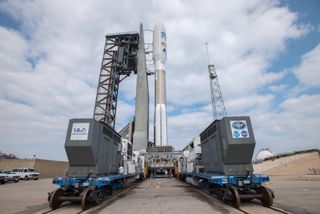
Space fans can catch a double dose of action in quick succession this afternoon (Nov. 19).
Three astronauts are scheduled to arrive at the International Space Station (ISS) today at 5:01 p.m. EST (2201 GMT), just 40 minutes before the next-generation GOES-R weather satellite lifts off. You can watch both events live here at Space.com courtesy of NASA TV, starting at 4:15 p.m. EST (2115 GMT).
NASA astronaut Peggy Whitson, cosmonaut Oleg Novitskiy and Thomas Pesquet of the European Space Agency launched into space atop a Russian Soyuz rocket Thursday afternoon (Nov. 17) from Baikonur Cosmodrome in Kazakstan. Their arrival at the ISS today will therefore bring a two-day space chase to an end. [Blastoff! New Crew Heads to Space Station (Video)]
While docking is slated to occur at 5:01 p.m. EST, the hatches between the space station and the newcomers' three-seat Soyuz spacecraft aren't scheduled to open until about 7:35 p.m. EST (0035 GMT on Sunday, Nov. 20), NASA officials said. You can watch the hatch-opening live as well, with coverage beginning at 6:45 p.m. EST (2345 GMT), also courtesy of NASA TV.
Whitson, Novitskiy and Pesquet will join current ISS commander Shane Kimbrough of NASA and cosmonauts Sergey Ryzhikov and Andrey Borisenko, bringing the orbiting lab up to its full complement of six crewmembers.
If you're looking for something to keep you entertained between docking and hatch-opening, check out the launch of GOES-R. The weather satellite is scheduled to lift off atop a United Launch Alliance Atlas V rocket at 5:42 p.m. EST (2242 GMT), from Cape Canaveral Air Force Station in Florida.
If all goes according to plan, the satellite will set up shop 22,300 miles (35,890 kilometers) above Earth and, after a roughly yearlong commissioning phase, provide images of weather patterns over the United States as frequently as every 30 seconds.
Get the Space.com Newsletter
Breaking space news, the latest updates on rocket launches, skywatching events and more!
GOES-R is the first in a series of four planned satellites that will update the Geostationary Operational Environmental Satellite network, which currently consists of two working spacecraft, known as GOES-East and GOES-West, as well as an on-orbit spare.
The new GOES satellites "will provide advanced imaging with increased spatial resolution and faster coverage for more accurate forecasts, real-time mapping of lightning activity and improved monitoring of solar activity," officials with the U.S. National Oceanic and Atmospheric Administration (NOAA), which manages the GOES-R program with help from NASA, wrote in a mission description.
GOES-R will be renamed GOES-16 once it reaches orbit, NOAA officials have said.
Follow Mike Wall on Twitter @michaeldwall and Google+. Follow us @Spacedotcom, Facebook or Google+. Originally published on Space.com.
Join our Space Forums to keep talking space on the latest missions, night sky and more! And if you have a news tip, correction or comment, let us know at: community@space.com.

Michael Wall is a Senior Space Writer with Space.com and joined the team in 2010. He primarily covers exoplanets, spaceflight and military space, but has been known to dabble in the space art beat. His book about the search for alien life, "Out There," was published on Nov. 13, 2018. Before becoming a science writer, Michael worked as a herpetologist and wildlife biologist. He has a Ph.D. in evolutionary biology from the University of Sydney, Australia, a bachelor's degree from the University of Arizona, and a graduate certificate in science writing from the University of California, Santa Cruz. To find out what his latest project is, you can follow Michael on Twitter.
